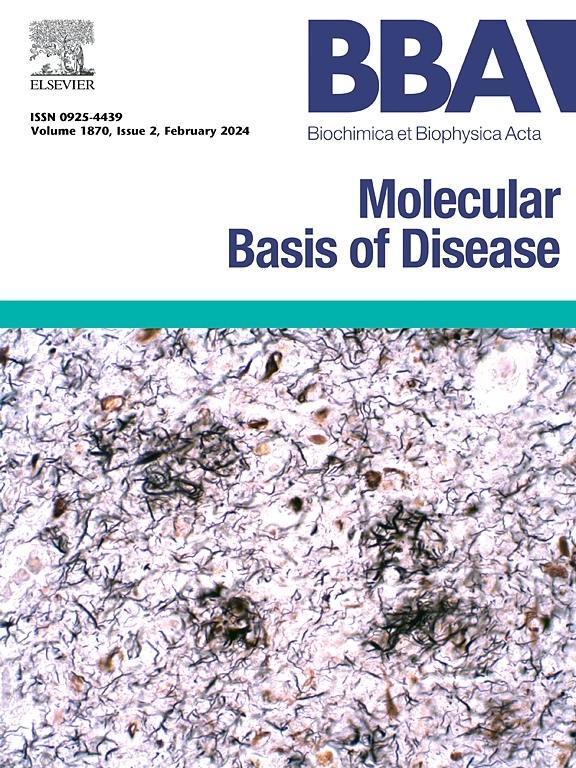LILRB4通过促进炎症和焦亡加重心肌缺血再灌注损伤。
IF 4.2
2区 生物学
Q2 BIOCHEMISTRY & MOLECULAR BIOLOGY
Biochimica et biophysica acta. Molecular basis of disease
Pub Date : 2025-06-21
DOI:10.1016/j.bbadis.2025.167959
引用次数: 0
摘要
炎症和焦亡是心肌缺血再灌注损伤的关键。尽管白细胞免疫球蛋白样受体亚家族B4 (LILRB4)在心肌肥大等情况下调节炎症,但其在心肌缺血再灌注损伤(MIRI)中的作用仍不清楚。设计重组腺病毒载体在H9C2心肌细胞或大鼠心肌组织中诱导LILRB4过表达或低表达。H9C2细胞缺氧2 h,再充氧4 h (h /R),心肌组织缺血30 min,再灌注2 h (I/R)。对心肌细胞和组织进行生化、组织病理学、ELISA等检测。同时,利用LILRB4敲除小鼠进行进一步验证。LILRB4促进I/R和H/R诱导的炎症因子的释放,从而增加心肌梗死的大小,导致功能损害。LILRB4的下调抑制了SHP-2的磷酸化和活化,从而降低硫氧还蛋白相互作用蛋白(TXNIP)、nod样受体蛋白3 (NLRP3)、Caspase-1和Gasdermin D (GSDMD)的表达。SHP2抑制剂PHPS1可减轻H/R诱导的LILRB4对心肌细胞的炎症和焦亡作用。与野生型小鼠相比,LILRB4-/-小鼠I/R诱导后心肌组织肿胀明显减轻,炎症因子释放减少,p-SHP2、TXNIP、NLRP3、Caspase-1、GSDMD蛋白表达明显降低。LILRB4促进炎症和焦亡,进而恶化MIRI,可能通过激活TXNIP/NLRP3信号通路,提供MIRI的机制见解。本文章由计算机程序翻译,如有差异,请以英文原文为准。
LILRB4 exacerbates myocardial ischemia-reperfusion injury by promoting inflammation and pyroptosis
Inflammation and pyroptosis are pivotal in myocardial ischemia-reperfusion injury. Although leukocyte immunoglobulin-like receptor subfamily B4 (LILRB4) modulates inflammation in conditions such as myocardial hypertrophy, its involvement in myocardial ischemia-reperfusion injury (MIRI) remains ambiguous. Recombinant adenoviral vectors were designed to induce the overexpression or knockdown of LILRB4 in H9C2 cardiomyocytes or rat myocardial tissue. H9C2 cells were subjected to hypoxia for 2 h and reoxygenation for 4 h (H/R), while myocardial tissue experienced 30 min of ischemia followed by 2 h of reperfusion (I/R). Biochemical assay, histopathology, ELISA, and other tests were performed on myocardial cells and tissues. Meanwhile, LILRB4 knockout mice were used for further validation. LILRB4 promotes the release of inflammatory factors induced by I/R and H/R, thereby increasing the size of myocardial infarction and leading to functional impairment. Downregulation of LILRB4 suppressed SHP-2 phosphorylation and activation, consequently reducing the expression of the thioredoxin-interacting protein (TXNIP), NOD-like receptor protein 3 (NLRP3), Caspase-1, and Gasdermin D (GSDMD). The SHP2 inhibitor PHPS1 mitigated the inflammatory and pyroptotic effects of LILRB4 in cardiomyocytes induced by H/R. Compared to wild-type mice, LILRB4−/− mice exhibited markedly diminished myocardial tissue swelling, decreased release of inflammatory cytokines, and a notable reduction in the expression of p-SHP2, TXNIP, NLRP3, Caspase-1, and GSDMD proteins after I/R induction.LILRB4 promotes inflammation and pyroptosis, which in turn worsens MIRI, likely through activating the TXNIP/NLRP3 signaling pathway, providing mechanistic insights into the MIRI.
求助全文
通过发布文献求助,成功后即可免费获取论文全文。
去求助
来源期刊
CiteScore
12.30
自引率
0.00%
发文量
218
审稿时长
32 days
期刊介绍:
BBA Molecular Basis of Disease addresses the biochemistry and molecular genetics of disease processes and models of human disease. This journal covers aspects of aging, cancer, metabolic-, neurological-, and immunological-based disease. Manuscripts focused on using animal models to elucidate biochemical and mechanistic insight in each of these conditions, are particularly encouraged. Manuscripts should emphasize the underlying mechanisms of disease pathways and provide novel contributions to the understanding and/or treatment of these disorders. Highly descriptive and method development submissions may be declined without full review. The submission of uninvited reviews to BBA - Molecular Basis of Disease is strongly discouraged, and any such uninvited review should be accompanied by a coverletter outlining the compelling reasons why the review should be considered.

 求助内容:
求助内容: 应助结果提醒方式:
应助结果提醒方式:


